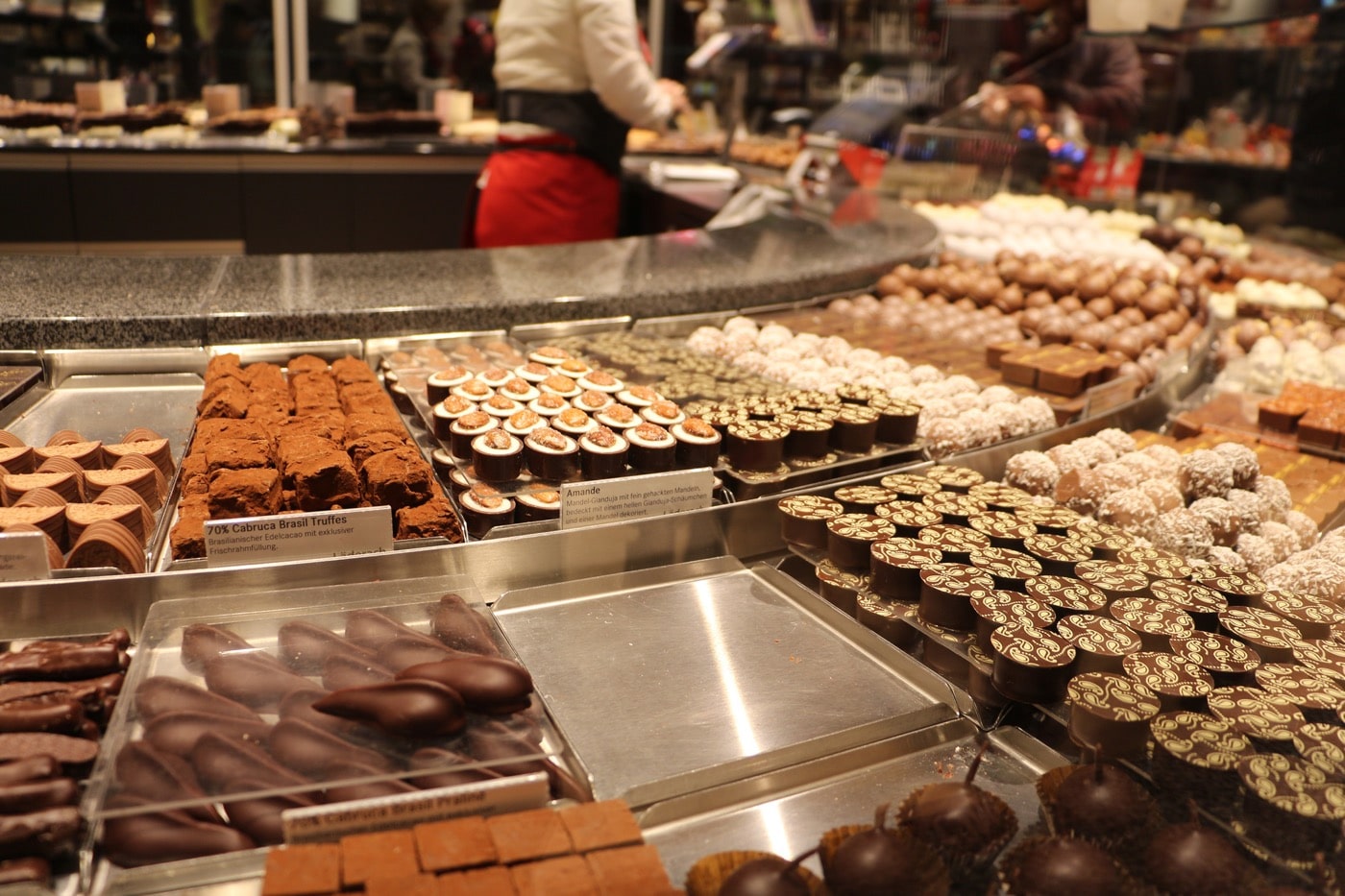Cheese and chocolate – as much a part of Switzerland as banks and watches. But, those are not edible and tasting local favorites is one of the highlights of traveling.
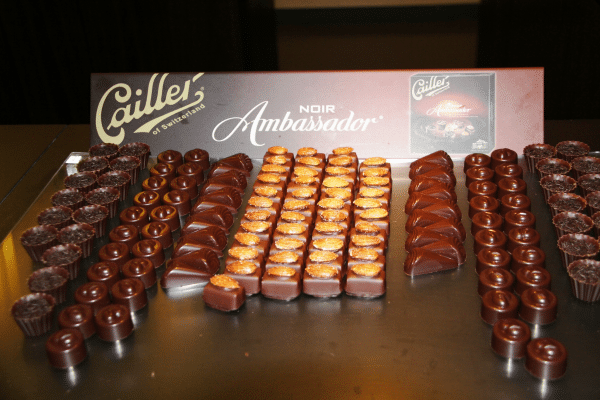
A great destination in Switzerland for savoring the best of both cheese and chocolate is the Fribourg region in the western part of the country. Visit beautiful towns, Fribourg, Gruyères and Murten, and head to nearby cheese and chocolate factories for tasting and purchasing if you wish.
Let’s start with cheese and Gruyères. The town that gave its name to one of Switzerland’s best known cheeses, Gruyère, is the quintessential Swiss burg with flower-bedecked rustic chalets and superb mountain views. It was named among the 14 most beautiful villages in Europe by Travel and Leisure magazine. The town has an interesting museum, a castle and restaurants with the perfect ambience to enjoy that cheese favorite, fondue.
My favorite part of the town castle is the gardens – giant splashes of color surrounded by ancient walls with a mountain backdrop. The castle film is another winner – an entertaining multimedia production on the castle’s history. Birds fly onto the screen from the ceiling. Horse hooves pound. Monks chant in ancient Latin. There’s a battle, a fire, flashing lights, shouts and screams. Fun entertainment.
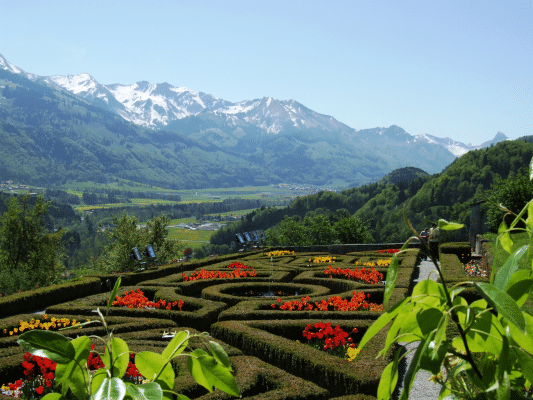
The HR Giger Museum features three floors of grotesque and strange art from the Swiss surrealist and Academy Award winning designer of “Alien.” It’s dark and mystical — and weird. The nearby Giger bar with its Giger oversized skeleton like chairs and ceiling is also a bit off the wall. The bar is next to a retirement center so most of the regular patrons are senior citizens who seem out of place in this far out environment.
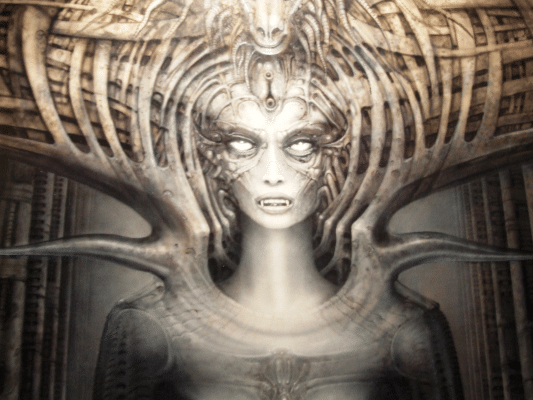
Gruyères is the place to try fondue. This Swiss specialty is made throughout the country, using different mixtures of Swiss cheeses. However, an authentic fondue should always be part Gruyère cheese. In Gruyères fondue is made with half Gruyère and half Vacherin cheese. Swiss dry white wine is the beverage of choice to accompany fondue.
For more cheese, visit the co-op demonstration dairy, La Maison du Gruyère, located in Pringy just outside the town. Walk through the second floor of the building, past various exhibits and view cheese making in progess as you listen to commentary on a headset. The cows that are responsible for the distinctive cheese graze in high mountain pastures in the summer, feeding on various grasses – 220 pounds per cow per day. They spend the winter in barns and are fed hay. That diet, as well as following the production steps of an ancient recipe, makes Gruyère special. Each cow produces 26 gallons of milk per day.
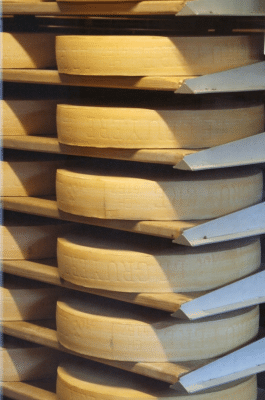
For sanitary reasons, cheese production is behind glass, but you can watch blades turn in enormous vats of curdled milk and view row upon row of giant cheese rounds, each weighing 77 pounds. The dairy produces 48 of these gigantic wheels of cheese each day. The rounds age from three months to one year, with the older (my favorite) having a much stronger taste. Some 7,000 rounds are stored continually in the Gruyère cellars.
At the end of the tour visitors are given a package with three different types of Gruyère to sample. And, if you want to take some home, the shop sells all varieties, as well as Swiss souvenirs.
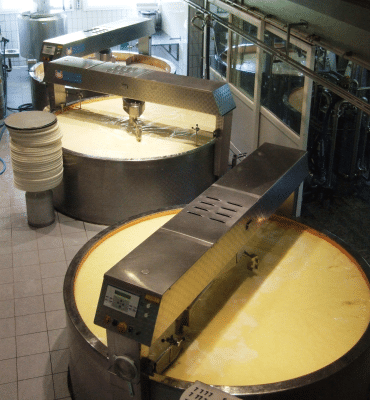
But my advice is to save some money for chocolate. The Maison Cailler Chocolate Factory, the “most visited place in western Switzerland,” is located in nearby Broc. “Yesterday we had 2,200 visitors,” a guide told us. No wonder. It’s delightful and delicious. The tasting (all sorts of chocolate pralines and as much as you want) is preceded by a fun and informative multimedia tour. Visitors are divided into small groups for the tour which leads through several dimly lit rooms with moving exhibits illustrating the history of chocolate. There’s commentary, sound effects, smoke, flashing lights and more. You’ll learn that Spanish Conquistador Don Hernán Cortés went to America seeking yellow gold, but came back with brown gold, cocoa beans. The Jesuits liked hot chocolate. The Pope said it was permissible to drink it during Lent. Marie Antoinette wanted hot chocolate for her last meal… plus more chocolate trivia.
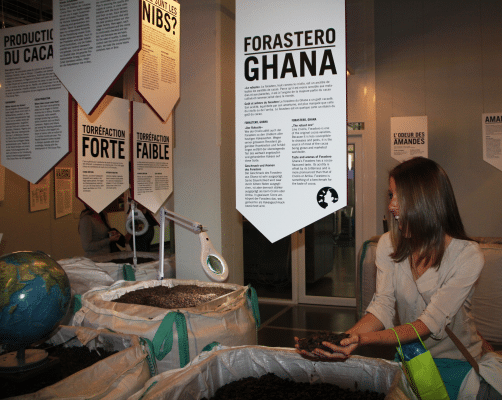
Move on to a room full of huge canvas bags of cocoa beans from different parts of the world. Then, watch the automated chocolate production where robots do most of the work. The grand finale – a room with dozens of trays of all kinds of filled chocolates. It’s hard not to overindulge. “Oh, just one more,” you say as another tray of yet another variety is placed before you. Of course, you can’t leave without passing through the shop which offers all sizes and flavors of Cailler chocolate bars.
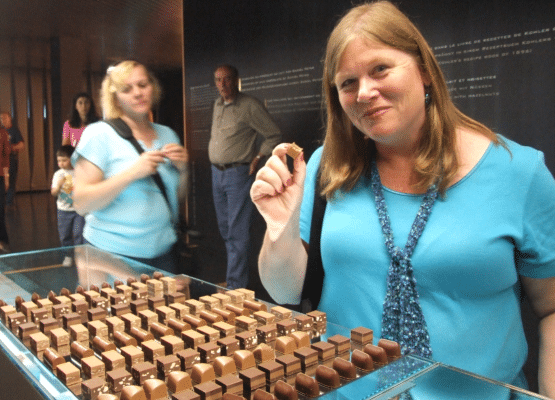
It would be a pity to limit your focus to cheese and chocolate and neglect the main city of the region, Fribourg. This charming medieval city occupies a dramatic site on a rocky spur at a bend in the Sarine River, the dividing line between both the German and French speaking sections of the country, as well as the city which is bilingual. Places on the west river bank in Fribourg have French names; those on the east, German names.
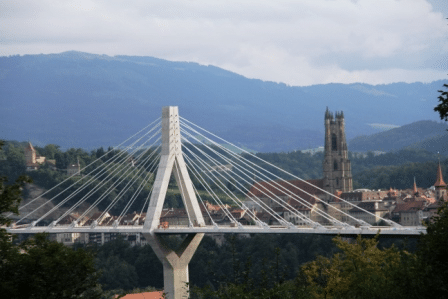
Switzerland has four official languages, yet the majority of the population speaks German (74%) followed by French (21%), Italian (4%) and just 1%, Rhaeto-Romanic or Rumantsch. Fribourg today claims more French speakers than German, although in the distant past the opposite was true. Fribourg was founded in 1157, with its name derived from the German frei (free) and Burg (fort).
A steep set of steps connects Fribourg’s upper and lower towns, a distance of some 330 feet. Trekking between the two can easily make you out of breath, so stop for a rest and admire stunning views of rooftops, steeples, rugged cliffs, distant mountains and the river below. That, too, can take your breath away.
The Basse Ville, (lower town), the historic old town on the river bank, is a medieval treasure. Wander across its bridges, along twisting, skinny streets, past ancient fountains and gothic houses. The upper town is the new town with a busy shopping street, a university, train station and more.
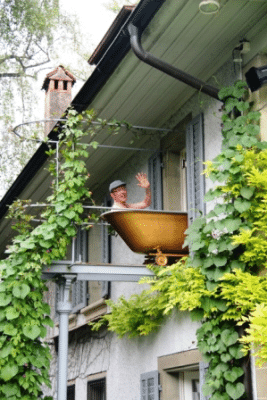
The pleasant city of 33,000 is noted for excellent cuisine (14 gourmet restaurants) and its native son, the artist Jean Tinguely (1925-1991), famous for his bizarre moving creations made of mechanical scraps and other used materials. Tinguely’s fountain symbolizes a car crash and is the piece de resistance in the city park paying tribute to the Formula I racer Joe Siffert who died in a racing accident. More of his off the wall creations, many powered by water or electricity, are in the museum, Espace Jean Tinguely – Niki de Saint Phalle, a former tramway depot. French artist Saint Phalle was Tinguely’s companion. Her works, whimsical, brightly colored feminine shapes known as “nanas,” are another attraction in this amusing and amazing museum.
Also in the amazing category is Fribourg’s funicular, dating from 1899 and constructed using waste water for power. It connects the upper and lower towns and is still powered with recycled water. “Ecology before our time,” commented a guide.
Fribourg’s Gothic cathedral, St. Nicholas, is a city landmark with its 225 foot high tower jutting above the town’s red rooftops. Stained glass windows by the Polish painter Jozef Mehoffer are outstanding examples of religious Art Nouveau.
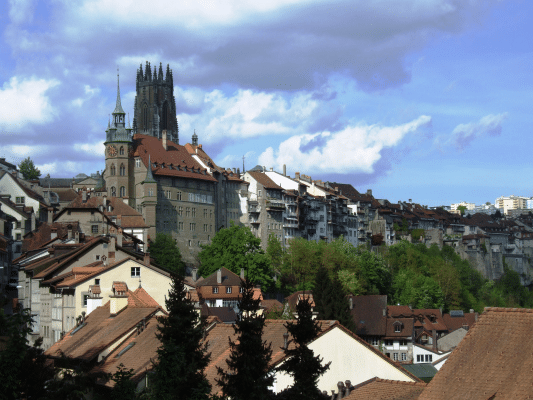
Another gem of a town in the region is Murten, straddling the shores of a lake by the same name in the heart of the three lakes region between Bern and Lausanne. This medieval town is the capital of the Lake District in the Swiss canton of Fribourg. Murten’s ancient walls surrounding the town still stand with 12 of their 14 original towers. Stroll along the ramparts walkway for stunning views of the lake, distant hills and mountains, and the tile rooftops at your feet. You’ll find plenty of photo opps.
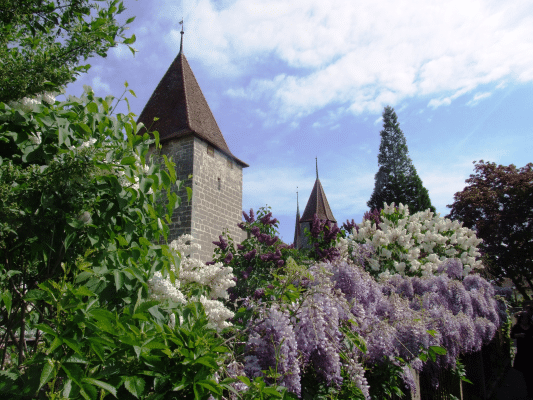
Inside the walls, where 400 of the town’s 6,000 residents live, there’s more Middle Ages ambience with a wide cobbled street bordered by arcades with intriguing shops. One sells dozens of kinds of schnapps and grappas, 30 different kinds of cooking oils and 25 different vinegars. A bakery window beckons with displays of the local specialty, Nidelkuchen, a luscious cream cake with caramel frosting. There’s a flower shop, a butcher, clothing boutiques and cafes with outdoor tables.
Murten was destroyed by fire in 1416 and entirely rebuilt in stone. Most of the houses within the walls date from that period and are under national protection. They must have tile roofs and are not permitted to have antennas. The city gate is a clock tower with a working clock that dates to 1712. Every day it’s wound by hand. “First Swiss quality,” commented a local. “
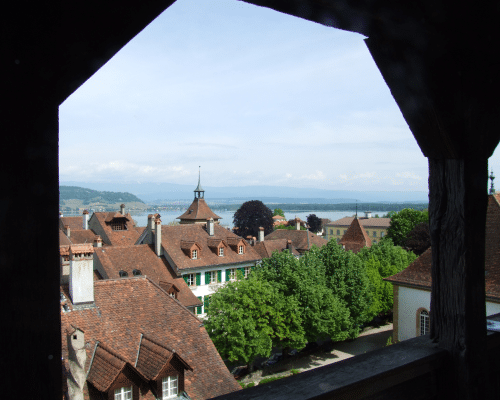
Like Fribourg, Murten is on the border of the French and German speaking regions of Switzerland with one fourth of its population listed as speaking French while the rest speak German. “Most people communicate in both languages,” said a guide who explained that both French and German are taught in schools.
“The French are not extremely serious,” she said. “They are apt to drink a glass of wine more frequently. The Germans are strict and serious. To live together we have to adapt. One culture learns from the other.” No doubt some of those German speakers have learned the pleasures of drinking wine from the French speakers whom they join for boat excursions across the lake to the opposite shore where vineyards cover the slopes and wonderful wines can be tasted at local wineries.
The area code for Switzerland is 41.
[alert type=white]
Where to Stay:
Hotel Restaurant Au Sauvage – In the heart of Fribourg’s old town, Basse Ville. This magnificent 16th century residence is a small hotel offering a quiet and calm ambience. Comfortable rooms and excellent service. Planche-Superieure 12, 1700 Fribourg, (0) 26 347 30 60 www.hotel-sauvage.ch
NH Fribourg Hotel – Situated in the center of Fribourg (upper city) it’s convenient for visiting the picturesque town and nearby attractions. Large, modern and comfortable. Grand Places 14, 1700 Fribourg, (0) 26 351 91 91. www.nh-hotels.com
Hotel Fleur de Lys – Located in the center of Gruyères, this small hotel offers comfortable rooms in a rustic ambience. Restaurant features local specials. Rue du Bourg 14, 1663 Gruyeres, (0) 26 921 82 82, www.hotelfleurdelys.ch
Auberge aux 4 Vents – A unique small hotel outside of Fribourg surrounded by beautiful gardens. Just eight rooms, each with a different period décor. The Blue Room features a moveable bathtub – press a button and the tub glides to an outside platform with gorgeous mountain views. Gourmet restaurant. Grandfey 124, 1763 Granges-Paccot, (0) 26 321 56 00, http://aux4vents.ch
Where to Eat:
Pinte des Trois Canards – Located outside Fribourg above a raging mountain stream. Mountain trout is the special and the restaurant has 30 different ways to prepare it. Chemin du Gottéron 102, 1700 Fribourg, (0) 26 321 28 22, www.pintedestroiscanards.blogspot.ch
Auberge aux 4 Vents and Hotel Fleur de Lys, see above.
Le Chalet de Gruyères – A fondue chalet par excellence. Rustic, woodsy, cozy. Fondue and other cheese specials are the highlights. Rue de Bourg 53, 1663 Gruyères, (0) 26 921 21 54, http://www.gruyeres-hotels.ch/chaletdegruyeres/index.html
Restaurant des Bains – A delightful eatery on the shores of Lake Murten with a large lakeside terrace. Fish from the lake are especially popular. Ryf 35, 3280 Murten, (0) 26 670 23 38, www.desbains-murten.ch
What to See and Do:
La Maison du Gruyère – Learn all about this famous cheese. Open daily from 9 a.m. to 7 p.m., May thru October and until 6 p.m. October thru May. Cheese making from 9 a.m. until 11 a.m. and from 12:30 p.m. to 2:30 p.m. Admission is 7 Swiss Francs. Place de la Gare 3, 1663 Pringy, (0) 26 921 84 00, www.lamaisondugruyere.ch/
Maison Cailler Chocolate Factory – Enjoy a delightful multi-media visit and learn all about Switzerland’s premier chocolate. Plenty of free samples. Open daily April to October, 10 a.m. to 6 p.m.; November – March, 10 a.m. to 5 p.m. Admission: Adults,10 Swiss francs, Children up to 16 years, free. Rue Jules Bettel 7, 1636 Broc, (0) 26 921 59 60. www.cailler.ch
More on the Gruyère region: www.la-gruyere.ch
Espace Jean Tinguely-Niki de Saint Phalle – Admire the works of these two 20th century artists in a former tramway depot, turned museum. Rue de Morat, 1700 Fribourg, (0) 26 305 51 70.
Take a boat ride on Lake Murten from the town of Murten. Get off in Vully on the opposite shore to visit a winery and taste the area’s delicious vintages. More info at www.murten.ch
[/alert]

